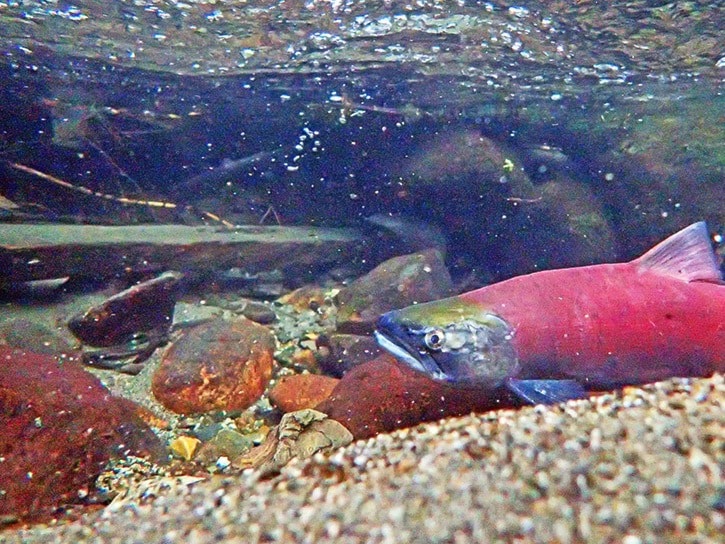Your nose knows when it’s salmon spawning season. Even before you get to the creek and see the splashing and the spent carcasses, you — and the bears — know that the time has come to check out the annual runs.
On Nov. 4 at the lower Kawkawa (Sucker) Creek spawning channel, it was clear that a bruin had been visiting, taking a sizable chunk out of a rotting chum salmon before perhaps leaving it for fresher fare.
The channel and the creek between Thacker Marsh and the Coquihalla River are currently populated by tens of spawning chum, with the odd coho thrown in. The female chum can be identified by the dark strip running down their midlines, while the males have blotchy dark slashes on their sides. Coho have distinctive spots along their backs and may appear free of the fungal rot that has affected many chums, which started spawning earlier.
Fisheries and Oceans Canada (DFO) biologist, Matt Townsend said staffers have been doing their annual surveys of local streams. The audits run from October to January and include streams on the east side of Kawkawa Lake.
“The chums, we usually see from mid-October to the end of November and most are in what we call ‘1A.’ We don’t get a ton of them,” said Townsend, who works out of the DFO’s Delta office. 1A is the manmade spawning channel upstream of the parking lot on Union Bar Road.
Past records show the chum run peaking from Nov. 5 to 12, though the coho are less predictable. “Run timing for coho was extremely variable,” a DFO report said in 2007, “beginning Oct. 9 to Dec. 3, peaking Oct. 28 to Jan. 4 and ending Dec. 21 to Jan. 18.”
Unlike chum, which stick to the waters from the Coquihalla River to the exit of Thacker Marsh, coho use all of Kawkawa Creek and the main streams on the east side of Kawkawa Lake.
Heavy rains can turn the Coquihalla and many west-coast streams into a murky, raging torrent — but Kawkawa Creek and the spring-fed east-side creeks remain fish-friendly.
“Our surveyors keep Kawkawa in their back pockets for rainy days because the streams don’t get blown out,” said Townsend. “The lake has a modifying effect on the outflow stream, too.”
Moderate flows, clear waters and narrow channels make the counting easier and more accurate.
Provincial authorities have also been monitoring the lake and east side streams for the health of sport fishing stocks, especially the kokanee salmon. Kokanee are a strain of sockeye salmon that spend all of their lives in fresh water. As a result, they don’t see the large growth of their ocean-going cousins — though they mirror the sockeye’s red bodies and greenish heads during spawning season.
Mike Willcox, a fish biologist for the Ministry of Forests, Lands and Natural Resource Operations is in charge of a three-year study of the Kawkawa fishery, which started this summer, using two UBC student researchers to gather data.
“The kokanee spawner counts are a part of a broader, multi-year project, entitled ‘Assessment of Kawkawa Lake Kokanee: fishery, stock and spawning,” said Willcox via e-mail. “The ultimate objective of the project is to provide our agency with monitoring and management recommendations to ensure the continued existence of this unique, popular and productive kokanee fishery.”
Summertime work included surveys of fishers at the west-side boat launch and nighttime sonar and gillnetting. This fall, the students conducted assessments of the health of the spawning streams — and visual counts of spawners in the streams began in October.
“Peak counts were in late October and numbered approximately 800 fish total for all streams,” said Willcox. “Kopp, Menz and Stephens creeks had the vast majority of spawners but a few were seen in the creeks up the road.
“Peak daily counts in the 1980s and early 90s ranged from as low as 400 to as high as 4000,” he added. “The population of spawners has yet to be determined as the counts have not been completed — one more will be undertaken this week. The weekly counts will be plotted on a graph and an ‘area under the curve’ method will be used to get a total estimate.”
The stream/ditch at the corner of Stephens and Kawkawa Lake Roads offers the best access for viewing the kokanee, though the bulk of the run has passed. Keep an eye on the larger streams for coho, while respecting wildlife and private property.
